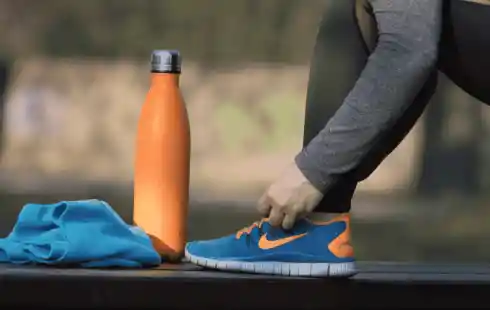
Oktoberfest in the news: How people around see beer's birthday
Section: Arts
 Veins play a pivotal role in the circulatory system, facilitating the transport of blood back to the heart. However, the health of these crucial vessels is often overlooked until issues such as varicose veins or deep vein thrombosis arise. To promote vascular wellness and prevent complications, experts advocate for proactive measures aimed at keeping veins healthy. From lifestyle adjustments to targeted interventions, here are essential strategies for nurturing vascular vitality.
Veins play a pivotal role in the circulatory system, facilitating the transport of blood back to the heart. However, the health of these crucial vessels is often overlooked until issues such as varicose veins or deep vein thrombosis arise. To promote vascular wellness and prevent complications, experts advocate for proactive measures aimed at keeping veins healthy. From lifestyle adjustments to targeted interventions, here are essential strategies for nurturing vascular vitality.
Understanding Vein Health:
Before delving into preventive measures, it's vital to grasp the fundamentals of vein health. Veins are tasked with returning deoxygenated blood to the heart, overcoming gravity and other physiological challenges in the process. When veins become compromised, whether due to weakened valves, increased pressure, or other factors, circulation may be impeded, leading to discomfort, swelling, and potential complications.
1. Stay Active:
Regular physical activity stands out as one of the most effective ways to maintain healthy veins. Engaging in exercises that promote muscle contraction, such as walking, cycling, or swimming, aids in venous return by facilitating blood flow back to the heart. Additionally, targeted leg exercises can strengthen the calf muscles, which play a crucial role in assisting venous blood flow from the lower extremities.
2. Elevate Your Legs:
For individuals prone to prolonged periods of sitting or standing, elevating the legs periodically can alleviate pressure on the veins and improve circulation. Elevating the legs above heart level for short intervals throughout the day helps counteract the effects of gravity, reducing the risk of blood pooling in the lower extremities and the development of varicose veins.
3. Maintain a Healthy Weight:
Excess weight exerts additional strain on the circulatory system, increasing the risk of venous insufficiency and related conditions. By adopting a balanced diet and incorporating regular exercise into their routine, individuals can achieve and maintain a healthy weight, thereby reducing the burden on their veins and promoting optimal circulation.
4. Supportive Footwear:
The choice of footwear can impact venous health, particularly for individuals who spend long hours on their feet. Opting for supportive shoes with adequate arch support and cushioning helps promote proper blood flow and reduces the risk of venous insufficiency. Avoiding high heels and shoes with narrow toe boxes can also mitigate pressure on the veins and lower the likelihood of developing foot and leg discomfort.
5. Compression Therapy:
Compression stockings offer a non-invasive approach to managing venous issues by exerting gentle pressure on the legs, promoting blood flow, and preventing blood from pooling in the veins. These specialized garments come in various compression levels and styles, ranging from knee-high socks to full-length stockings, catering to individuals with different needs and preferences.
6. Hydration is Key:
Adequate hydration is essential for maintaining healthy blood viscosity and supporting efficient circulation. By drinking plenty of water throughout the day, individuals can help prevent dehydration, which can exacerbate venous issues and contribute to symptoms such as leg cramps and swelling. Limiting the consumption of caffeinated and alcoholic beverages, which can have diuretic effects, is also advisable.
7. Incorporate Dietary Support:
Certain dietary factors can influence vein health and circulation. Consuming foods rich in flavonoids, such as berries, citrus fruits, and dark leafy greens, may help strengthen vein walls and improve vascular function. Additionally, incorporating foods high in fiber, such as whole grains, legumes, and vegetables, can promote regular bowel movements, reducing the risk of constipation, a common contributor to venous issues.
8. Minimize Prolonged Sitting or Standing:
Individuals whose occupations or lifestyle necessitate prolonged periods of sitting or standing should take regular breaks to move and stretch their legs. Simple activities such as taking short walks, performing calf raises, or flexing and extending the ankles can help stimulate blood flow and prevent venous stasis.
9. Avoid Smoking:
Smoking not only damages blood vessels and compromises circulation but also contributes to a host of other health problems, including cardiovascular disease and cancer. Quitting smoking is crucial for preserving vascular health and reducing the risk of venous complications.
10. Regular Check-ups:
Lastly, scheduling regular check-ups with a healthcare provider allows for early detection and intervention in case of any underlying venous issues. Screening tests such as ultrasound can assess vein health and identify potential abnormalities, enabling timely management and preventive measures.
In conclusion, prioritizing the health of veins is paramount for overall well-being and longevity. By implementing these expert-recommended strategies into their daily lives, individuals can nurture vascular vitality, reduce the risk of venous disorders, and enjoy optimal circulation and comfort for years to come.
Image by Gesina from Pixabay

Section: Arts

Section: Business

Section: Business

Section: Arts

Section: Health

Section: Arts

Section: News

Section: News

Section: Arts

Section: Business
Health Insurance in Germany is compulsory and sometimes complicated, not to mention expensive. As an expat, you are required to navigate this landscape within weeks of arriving, so check our FAQ on PKV. For our guide on resources and access to agents who can give you a competitive quote, try our PKV Cost comparison tool.
Germany is famous for its medical expertise and extensive number of hospitals and clinics. See this comprehensive directory of hospitals and clinics across the country, complete with links to their websites, addresses, contact info, and specializations/services.
One of the most beautiful squares transforms into a summer stage every year for two days. The Gärtnerplatz Open-Air features a free music and cultural program across three stages, as well as street food from local vendors. On Saturday, the main stage at Gärtnerplatz offers something for everyone,...



No comments yet. Be the first to comment!